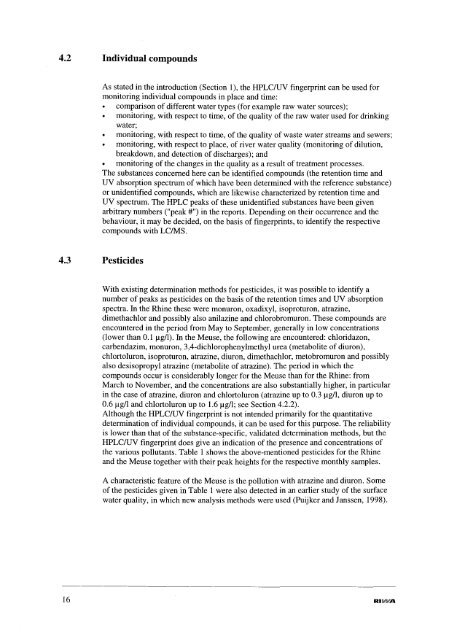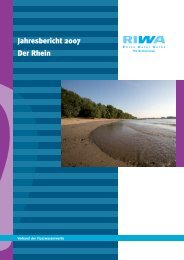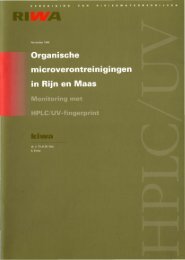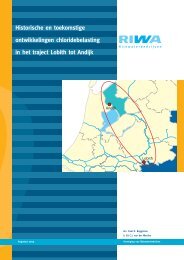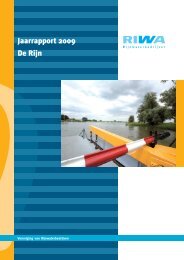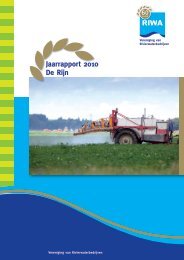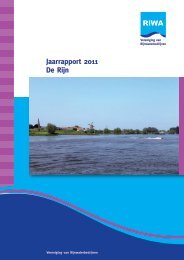Organic micropollutants in Rhine and Meuse a - Riwa
Organic micropollutants in Rhine and Meuse a - Riwa
Organic micropollutants in Rhine and Meuse a - Riwa
Create successful ePaper yourself
Turn your PDF publications into a flip-book with our unique Google optimized e-Paper software.
4.2 Individual compounds<br />
As stated <strong>in</strong> the <strong>in</strong>troduction (Section 1), the HPLC/UV f<strong>in</strong>gerpr<strong>in</strong>t can be used for<br />
monitor<strong>in</strong>g <strong>in</strong>dividual compounds <strong>in</strong> place <strong>and</strong> time:<br />
comparison of different water types (for example raw water sources);<br />
• monitor<strong>in</strong>g, with respect to time, of the quality of the raw water used for dr<strong>in</strong>k<strong>in</strong>g<br />
water;<br />
monitor<strong>in</strong>g, with respect to time, of the quality of waste water streams <strong>and</strong> sewers;<br />
• monitor<strong>in</strong>g, with respect to place, of river water quality (monitor<strong>in</strong>g of dilution,<br />
breakdown, <strong>and</strong> detection of discharges); <strong>and</strong><br />
• monitor<strong>in</strong>g of the changes <strong>in</strong> the quality as a result of treatment processes.<br />
The substances concerned here can be identified compounds (the retention time <strong>and</strong><br />
UV absorption spectrum of which have been determ<strong>in</strong>ed with the reference substance)<br />
or unidentified compounds, which are likewise characterized by retention time <strong>and</strong><br />
UV spectrum. The HPLC peaks of these unidentified substances have been given<br />
arbitrary numbers ("peak #") <strong>in</strong> the reports. Depend<strong>in</strong>g on their occurrence <strong>and</strong> the<br />
behaviour, it may be decided, on the basis of f<strong>in</strong>gerpr<strong>in</strong>ts, to identify the respective<br />
compounds with LCIMS.<br />
4.3 Pesticides<br />
With exist<strong>in</strong>g determ<strong>in</strong>ation methods for pesticides, it was possible to identify a<br />
number of peaks as pesticides on the basis of the retention times <strong>and</strong> UV absorption<br />
spectra. In the' Rh<strong>in</strong>e these were monuron, oxadixyl, isoproturon, atraz<strong>in</strong>e,<br />
dimethachlor <strong>and</strong> possibly also anilaz<strong>in</strong>e <strong>and</strong> chlorobromuron. These compounds are<br />
encountered <strong>in</strong> the period from May to September, generally <strong>in</strong> low concentrations<br />
(lower than 0.1 Ilg/l). In the <strong>Meuse</strong>, the follow<strong>in</strong>g are encountered: chloridazon,<br />
carbendazim, monuron, 3,4-dichlorophenylmethyl urea (metabolite of diuron),<br />
chlortoluron, isoproturon, atraz<strong>in</strong>e, diuron, dimethachlor, metobromuron <strong>and</strong> possibly<br />
also desisopropyl atraz<strong>in</strong>e (metabolite of atraz<strong>in</strong>e). The period <strong>in</strong> which the<br />
compounds occur is considerably longer for the <strong>Meuse</strong> than for the Rh<strong>in</strong>e: from<br />
March to November, <strong>and</strong> the concentrations are also substantially higher, <strong>in</strong> particular<br />
<strong>in</strong> the case of atraz<strong>in</strong>e, diuron <strong>and</strong> chlortoluron (atraz<strong>in</strong>e up to 0.3 Ilg/l, diuron up to<br />
0.6 Ilg/1 <strong>and</strong> chlortoluron up to 1.6 Ilg/l; see Section 4.2.2).<br />
Although the HPLC/UV f<strong>in</strong>gerpr<strong>in</strong>t is not <strong>in</strong>tended primarily for the quantitative<br />
determ<strong>in</strong>ation of <strong>in</strong>dividual compounds, it can be used for this purpose. The reliability<br />
is lower than that of the substance-specific, validated determ<strong>in</strong>ation methods, but the<br />
HPLC/UV f<strong>in</strong>gerpr<strong>in</strong>t does give an <strong>in</strong>dication of the presence <strong>and</strong> concentrations of<br />
the various pollutants. Table 1 shows the above-mentioned pesticides for the Rh<strong>in</strong>e<br />
<strong>and</strong> the <strong>Meuse</strong> together with their peak heights for the respective monthly samples.<br />
A characteristic feature of the <strong>Meuse</strong> is the pollution with atraz<strong>in</strong>e <strong>and</strong> diuron. Some<br />
of the pesticides given <strong>in</strong> Table 1 were also detected <strong>in</strong> an earlier study of the surface<br />
water quality, <strong>in</strong> which new analysis methods were used (Puijker <strong>and</strong> Janssen, 1998).<br />
16 RIMifA


